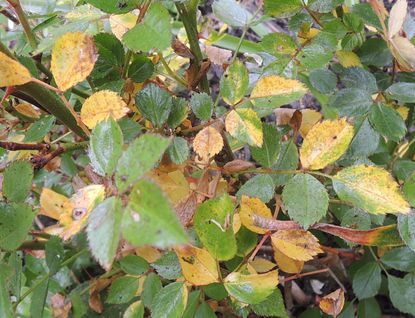Rose Leaves Turning Yellow? Here’s Why & How To Fix It
Rose leaves turning yellow is not uncommon, and it's often related to too much or not enough water. Insects and diseases can cause problems, too, but proper rose care is easy to learn.


Yellow Leaves on Roses? Common Causes & Fixes
When you see your rose leaves turning yellow, you may be concerned, and perhaps with good reason. Roses are a classic addition to many home landscapes. Beautiful newer cultivars have been bred for their hardiness and beauty in ornamental beds and borders. Open-pollinated and heirloom types continue to dazzle growers, as well.
Most rose species are considered highly resistant to disease and easy to grow. Learning more about the potential causes of chlorosis, or yellow leaves will help you decide whether there’s something you need to change. Roses often shed yellow leaves naturally for different reasons, so don’t automatically assume there’s something wrong. However, it’s good to pay attention to changes.
Why Are My Rose Leaves Turning Yellow?
While the exact cause of yellowing rose leaves can be a challenge to determine, it’s most likely the result of a combination of factors.
Roses have specific cultural needs. They include the amount of light the plant is receiving as well as the nutrient levels and moisture content within the soil. Yellowing leaves can indicate disease, but not always. For example, newly planted bushes will often show signs of stress as they acclimate to new growing conditions.
If leaves on the top portion of the bush are shading leaves lower down, the lower ones may turn yellow and shed from lack of light. This is not harmful to the plant. Roses can also become stressed with too much heat. Mulching around them may help.
To further diagnose your roses, be especially mindful of any additional symptoms displayed by the plants. Make note of other changes in the appearance of leaves, like wilting or the development of spots or lesions.
Common Causes of Yellow Leaves on Roses
In an otherwise healthy rose bush, leaves turning yellow may not be an immediate cause for concern. Issues related to watering are most common. The leaves of stressed rose plants may begin to yellow from overwatering or prolonged periods of underwatering.
Gardening tips, videos, info and more delivered right to your inbox!
Sign up for the Gardening Know How newsletter today and receive a free download of our most popular eBook "How to Grow Delicious Tomatoes."
Nutrient deficiencies in the soil may also change the appearance of the shrub’s foliage. Insufficient levels of iron, magnesium, and/or nitrogen can contribute to a plant’s change in color and may even lead to a sudden loss of vigor.
Yellow spots on rose leaves can often indicate disease. Yellowing of leaves is a common symptom of problems like black spot, rose mosaic disease, rust, and other fungal issues. Unexpected yellowing may also be caused by troubles with insects. Sucking pests like aphids, spider mites, and thrips are most problematic, feeding on tender leaves and delicate flower buds.
How to Treat Yellow Leaves on Roses
Yellowing rose leaves caused by changes in the plant’s care will usually clear up quickly. You can aid in the process by making sure the proper water levels are maintained. Never allow the bush to sit for any length of time in soggy soil.
Routine feeding also helps ensure that each plant’s needs are being met. Experienced growers suggest using balanced, water-soluble fertilizer. Yellow leaves can appear due to a lack of Nitrogen, magnesium, and iron.
Water your roses early in the morning, and occasionally rinse the entire bush gently to remove contaminants or visiting insects.
Yellowing leaves caused by disease require more attention. In most instances, diagnosing the problem starts with removing all infected leaves and stems from the shrub. Remove any plant debris from the growing space to help control the spread of disease. In severe cases, consult with your area’s extension service agent or visit your local garden center with a sample of the leaves to help you decide on a treatment.
How to Prevent Yellow Leaves on a Rose Bush
Yellowing leaves can often be prevented. At planting time, be certain that roses are situated where they will receive ample sun. Adequate spacing between each plant helps to increase airflow and further reduce the likelihood of disease.
Preventative sprays can also be used at this time to help reduce fungal infections throughout the summer season. This, in tandem with using proper watering techniques, should greatly improve the overall health of your rose bushes, keeping your rose beds and borders looking lush and vibrant.

Tonya Barnett has been gardening for 13 years. Flowers are her passion. She has trasformed her backyard into a cut flower garden, which she regularly chronicles on her YouTube channel http://www.youtube.com/@tonyawiththeflowers.
- Caroline BloomfieldManager of Marketing Communications
-
 How To Keep Peonies From Falling Over: 5 Fixes For Floppy Flowers
How To Keep Peonies From Falling Over: 5 Fixes For Floppy FlowersPeonies are cottage garden favorites, but they can be prone to flopping. Support peonies with these practical ideas that can double as attractive features.
By Melanie Griffiths
-
 9 Bird-Friendly Flowering Plants: Flowers That Attract Birds Through The Seasons
9 Bird-Friendly Flowering Plants: Flowers That Attract Birds Through The SeasonsChoose the right flowering plants and your garden will become a favorite hangout for avian visitors. Try these nine flowers that attract birds to your yard
By Tonya Barnett